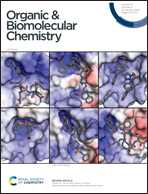Cucurbit[7]uril-driven modulation of ligand–DNA interactions by ternary assembly†
Abstract
The design of small organic molecules with a predictable and desirable DNA-binding mechanism is a topical research task for biomedicine application. Herein, we demonstrate an attractive supramolecular strategy for controlling the non-covalent ligand–DNA interaction by binding with cucurbituril as a synthetic receptor. With a combination of UV/vis, CD and NMR experiments, we demonstrate that the bis-styryl dye with two suitable binding sites can involve double stranded DNA and cucurbituril in the formation of the supramolecular triad. The ternary assembly is formed as a result of the interaction of macrocyclic cucurbituril with one pyridinium fragment of the bis-styryl dye, while the second pyridinium fragment of the dye is effectively associated with DNA backbones, which leads to a change in the ligand–DNA binding mode from aggregation to a minor groove. This exciting outcome was supported by molecular docking studies that help to understand the molecular orientation of the supramolecular triad and elucidate the destruction of dye aggregates caused by cucurbituril. These studies provide valuable information on the mechanisms of DNA binding to small molecules and recognition processes in bioorganic supramolecular assemblies constructed from multiple non-covalent interactions.
![Graphical abstract: Cucurbit[7]uril-driven modulation of ligand–DNA interactions by ternary assembly](/en/Image/Get?imageInfo.ImageType=GA&imageInfo.ImageIdentifier.ManuscriptID=C9OB02543J&imageInfo.ImageIdentifier.Year=2020)
- This article is part of the themed collections: Chemical Biology in OBC and Supramolecular chemistry in OBC


 Please wait while we load your content...
Please wait while we load your content...